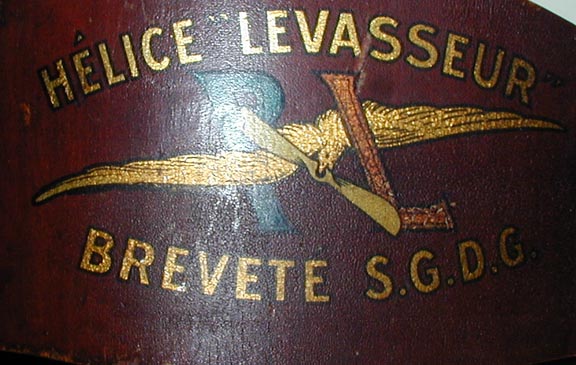I am a french surgeon in the middle of France ( Limoges ) And I Discoverd in the barn of my grand parents a wooden propeller that has been used for decenies as a perch for chiken....
They are die for years, they never saw a plane, they never tell anything to me about this propeller, and there was no pilot in my family, and no airport in the area.
It has been difficult for me at the bigining to understand that it was a propeller because of the thickness of chiken drops.
and infotunately it was impossible to keep the brown paint on the front side, and it is very spoilted on the back side.
I could save, using a incredible care, the PL BSGD stamps...
Since this moment, I am looking for the origin of this object.
I wrote mails to a lot of guys, I went on ( french ) forums dedicatid to old planes and somebody gave me your URL.
I just learned that it was a spécial ( biconvex?) shape that has been used Between 1912 ( Vickers N° 6 ) and 1915, when, in France, the name and type of the plane was stamped on any propeller.
here are the images: http://img42.imageshack.us/gal.php?g=imgp2221.jpg
Thank you for answering.
Friendly yours.
Jacques CHAMEAUD MD.
I am sorry my English is bad ( I spent more than one hour writing this Mail ! ) and I can't participate easyly to your forum, but of course I aloud you to use the images I send to you.
They are die for years, they never saw a plane, they never tell anything to me about this propeller, and there was no pilot in my family, and no airport in the area.
It has been difficult for me at the bigining to understand that it was a propeller because of the thickness of chiken drops.
and infotunately it was impossible to keep the brown paint on the front side, and it is very spoilted on the back side.
I could save, using a incredible care, the PL BSGD stamps...
Since this moment, I am looking for the origin of this object.
I wrote mails to a lot of guys, I went on ( french ) forums dedicatid to old planes and somebody gave me your URL.
I just learned that it was a spécial ( biconvex?) shape that has been used Between 1912 ( Vickers N° 6 ) and 1915, when, in France, the name and type of the plane was stamped on any propeller.
here are the images: http://img42.imageshack.us/gal.php?g=imgp2221.jpg
Thank you for answering.
Friendly yours.
Jacques CHAMEAUD MD.
I am sorry my English is bad ( I spent more than one hour writing this Mail ! ) and I can't participate easyly to your forum, but of course I aloud you to use the images I send to you.



Comment